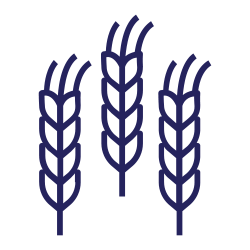Section Title
Managing an Unharvested Crop
Crop Types
- Whole Farm
This article was adapted from an article originally posted on the Alberta Agriculture and Forestry webpage.
Not every fall season presents conditions that allow for a completed harvest. More challenging harvests leave partial of full fields un-harvested until spring of the following year. This creates numerous challenges and questions around management of un-harvested crop. When approaching these challenges, each farm situation is different. For this this reason, there is no one size fits all answer. However, all producers with un-harvested crop need the same questions answered:
- How to capture the greatest value from the un-harvested crop?
- How can I extract that value at the lowest cost?
- How can I manage this un-harvested crop while minimizing both soil health impacts and impacts to subsequent crops?
The most important first step before taking any action on the un-harvested crop in question is to contact your crop insurance provider. It is best to ensure your management plans align with insurance recommendations. This ensures a proper assessment can be done on the crop and any potential value is captured.
As well, if the land is part of any land-use or conservation programs, check with facilitators to ensure your plans align with their guidelines regarding residue management.
Un-harvested crop can create significant logistic issues in the spring. With a growing season that is already restricting in some regions of the prairies, having a plan in place can reduce stress from the challenges presented.
First – Assess whether the crop is worth harvesting. The grain may have lost a grade or two but there may be more value in the crop than thought at first glance. Assess the potential value of the unharvested crops. This may require hand threshing the crop to acquire a representative sample. Depending on the potential value of that crop, you can then identify priority fields to manage.
If there is significant damage to the crop from wildlife or the crop is completely flat, harvesting is likely not an option or would provide minimal value for harvesting effort.
Second – Assess fields to gain an idea of what fields can be access in what order. Fields that historically dry up quicker can be managed earlier in the plan compared to fields you expect to take longer before field access can occur.
Third – Make decisions on how you want to manage the crop. This is the most challenging piece of the puzzle and requires multiple considerations including:
- Is the crop standing or swathed – a swathed crop may slow drying of the field and delay accessibility.
- Economics of the management option and end value of the material harvested.
- What will be seeded into that field afterward.
- Potential for equipment damage.
- Potential for soil impact from rutting.
Getting the most value from the un-harvested crop is important. However, if doing so impacts the quality of the field and therefore the potential of the following crop, careful consideration of these impacts needs to be taken.
Depending on your farm management and current situation, the crop can be managed in a variety of ways. Below is a table listing management options along with pro and con considerations.
The pros and cons of various mechanical management practices to harvest or manage un-harvested crops.
| Pros | Cons | |
|---|---|---|
| Combine | Allows for seed or residue collection and/or distribution.
Can manage a standing crop, tall stubble or swathed residue. Can be the best way to get the maximum value from the un-harvested crop. Less volunteers in subsequent crop. Readily available. |
Difficulty managing crop with high moisture.
May have difficulty picking up swaths, cutting a flattened crop or stubble. May be better to swath instead of straight combining to reduce the risk of equipment damage, so an additional operation is required. High operating cost; fuel, operating, depreciation and machine wear and tear. Ground will need to be frozen or dry to avoid soil rutting. |
| Baling and Bale Silage | Most all types of residue; standing or swath can be managed.
Once baled, residue can easily be handled or removed from field, used or dealt with later. Silage baler can manage high moisture residue Once collected the material can have many uses and potential revenue. Cheaper operating costs, then combining or chopping. Equipment is not as heavy as combine; less impact on wet soil. Less volunteers in subsequent crop. Readily available. |
Spoilage is a risk if baled at higher moisture.
Difficult to dispose of spoiled bales. Silage bales require extra management and monitoring before and after baling. Bale wrapping (silage) adds to cost. Bale wrappers are not readily available. |
| Grazing | Low cost
Livestock are generally available. Reduces time management, the animals do the harvesting. Other direct values such as manure/nutrients and possible revenue from feeding. |
Field needs to be fenced and a water source needs to be available.
Increases time management, animals need to be managed. Risk to livestock; ingesting contaminated/spoiled, fungus infected feed and forage. Applicability of this option depends on crop type. Animals can cause compaction in wet soils. Volunteer and weeds in subsequent crop. Cereal crops can be deficient in calcium & magnesium which can cause downer cows or milk fever. Be careful when grazing the material, as it is high energy grain with low energy straw, supplement and manage grazing so the animals don't experience grain overload, bloat or acidosis. |
| Mowing | Smaller horsepower tractors can be used.
Can cut/chop most residue types. Lower operating cost; fuel, machine wear and depreciation. Readily available |
Not effective in high moisture residue.
Will not widely distribute residue; multiple passes may be required. Less effective in swathed crop than un-swathed crop Volunteer plants and weeds in subsequent crop |
| Forage Chopper for Residue Spreading | Most all types of crop can be managed.
Can manage a high moisture residue if just spreading. Residue can easily be handled and removed from field and dealt with later. Chopped feed/forage crop results in higher palatability and if supplement is added, can be a high value product. Very aggressive; can widely spread and distribute chopped material over field If crop is chopped and removed from field, less volunteers in subsequent crop |
High cost if collected product has no value or use, more difficult to dispose of later.
Equipment is not readily available. High operating cost; fuel, machine wear and depreciation. Moderately heavy equipment; ground will need to be frozen or dry to avoid soil rutting. If crop is chopped and just spread in the field, issue with volunteer plants and weeds in subsequent crop. |
| Residue Stacking | Many different methods to stack residue; collect straw and chaff directly form combine, forage chopper to cut and blow windrows into stacker, pull-type pick-up and wagon.
Most all types of residue, standing or swathed can be managed. Residue stacks can be used as livestock feed and forage on field location; can be strategically placed. Residue can easily be handled and removed from field and dealt with later. If crop residue is removed from field, less volunteers in subsequent crop. |
Residue spoilage if stacked at higher moisture; heating.
More difficult to dispose of spoiled residue later. Could result in higher costs; depends on type of equipment and availability. Can be labour intensive if collected. |
| Conventional Tillage (Disc & cultivator) | Cuts, breaks and incorporates crop and residue.
Disc can handle more residue than a cultivator. Dissipates and spreads crop material. Many types of tillage tools; match the proper tool to field and crop conditions. Moderate operating cost; fuel, machine wear and depreciation. Readily available Volunteer plants and weeds in subsequent crop. |
Soil conditions must be dry.
May require multiple passes to manage un-harvested crop Soil and stubble disturbance; reduces soil structure, quality and cover. Releases green house gases. Not always effective in heavy ground cover, un-harvested swaths. The carbon offset market does not allow tillage practices (max. 10% of cropped area in the field) and will not pay offset dollars to producers if they till; carbon credits will be lost for that year on that field. Can cause compaction in wet conditions. |
| Vertical Tillage, Multi-tool and Other Specialized Tillage & Residue Management Equipment | Cuts, breaks and incorporates crop and residue
Dissipates and spreads crop material. Many types of tillage tools; match the proper tool to the field and crop conditions. Moderate operating cost; fuel, machine wear and depreciation. Readily available Vertical Tillage tools operate best at high speed; quick area coverage The carbon offset market does not allow tillage practices (max. 10% of cropped area in the field) and will not pay offset dollars to producers if they till; carbon credits will be lost for that year on that field. |
May require multiple passes
Soil and stubble disturbance; reduces soil structure, quality and cover. Results in release of greenhouse gasses. Not effective for swathed crops, research the proper tool before use. Has limitations in heavy residue situations. Requires higher horsepower than conventional tillage equipment. Volunteer plants in subsequent crop. |
| Harrowing | Dissipates and spreads residue piles.
Many types of harrowing tools; match the proper tool to the field and crop conditions. Low soil disturbance. Can operate at high speed; quick area coverage. Can be operated with low horsepower depending on tool type and residue. Low operating cost; fuel, machine wear and depreciation. Readily available |
May require multiple passes.
Soil surface and stubble disturbance; reduces topsoil structure, quality and cover. Not all harrow types will work in high residue situations. Limited effectiveness in un-swathed or swathed crop. Some equipment and residue situation may require high horsepower. Volunteer plants and weeds in subsequent crop. |
Additional Considerations
Disease impacts from overwintering?
The majority of disease issues occur prior to winter. However, prior to freeze up, fungi can grow on plant material of unharvested crop and potentially lead to increased mycotoxins levels. When harvesting the crop in the spring, if the crop looks excessively mouldy, it would be a good idea to test the grain for mycotoxins. If the grain is being fed to livestock, testing for mycotoxins is highly recommended. Excessively mouldy crop tissues may also lead to palatability issues.
In general, fungi have an advantage when the crop is green. In the winter, their impact in minimal. Thus, if there is a concern regarding disease risk to subsequent crops, one should focus on disease levels the previous summer on the growing crop in mid-late July or early August.
Downgrading from overwintering?
Sooty molds caused by naturally-occurring fungi will become more prevalent on dead plant material of any kind, including unharvested crops. These molds/mildews can be a downgrading factor.
Additionally, freeze damage, rodent excreta, and sprouting are also downgrading factors that can be more common in spring-seeded crops that overwinter.
How do I manage delayed seeding because of overwintered crop harvest?
This is a reality that comes with having to manage un-harvested crop. If possible, plan for parallel management of seed and harvesting. However, not all farms have the capacity to do this. If seeding is delayed due to having to harvest crop in the spring, consider utilizing an early-maturing crop or a silage crop that will reach desired maturity within the shortened season.
Can I seed directly into and unharvested crop?
If you determine the un-harvested crop will not be harvested or managed in any way, seeding directly into the crop can be done. However, keep in mind that a standing crop will create seeding challenges due to hair pinning, poor seed to soil contact, and emergence issues. These challenges may greatly impact crop uniformity, yield, and quality issues for the seeded crop.
Seeding into an unharvested crop may also present significant volunteer issues. More information this this can be found here (Link to article on volunteers).
What if I want to burn my crop?
If all other management options have been exhausted, you can consider burning the crop. Sometimes, this is the only option available. However, prior to implementing this management, check with your county or municipal district as most will require permits for crop burning. If you are in a Forest Protected Area of Alberta, you will need a fire permit from the Government of Alberta.
Check for fire bans in the area by checking government fire ban websites (AB: Here, SK: Here, MB: Here, BC: Here). As always, be sure to contact your insurance provider.
Take note, burning un-harvested crop will provide no value to you from the crop other than allowing access to the field and seeding of a new crop. Burning can negatively impact soil, create air quality issues and have been known to cause traffic accidents.
Should I burn my crop to remove the crop residue?
Research has shown that burning crop residues has more negative effects than positive. Burning reduces soil organic matter, carbon and nitrogen. Additionally, it can have negative effects on soil erosion, permeability and air quality. Finally, burning disrupts the balance of microorganisms in the soil reducing the biological activity and overall soil health
In cases where mechanical methods to remove the crop are not possible, or insufficient to handle the residue, burning could be used as a last resort to remove crop residues prior to seeding. Make sure to check with your crop insurance provider, and with municipal authorities, for permission to burn.
If you decide to burn: Burning tips
- Do you have your fire permit? Follow the directions on the permit or as directed by the municipality.
- If you plan on burning, make sure you also have sufficient property insurance in the event that your fire gets out of control, or spreads to neighboring land.
- Monitor your burn; don’t leave your field while it’s burning.
- Burn small areas at a time and avoid lighting the entire field on fire at once.
- Have a plan to deal with any emergencies.
- Have a water truck and other equipment on hand.
- Till the outside rounds of the field to create a fire break.
- You will also have to monitor after your burn.
- Consider baling the un-harvested crop, removing it from the field and later burning the bales away from your field. Burning the bales in a smaller controlled area is easier to monitor and manage than burning swaths in a field. This option will also help preserve the ground cover, residue and organic matter in the field.









